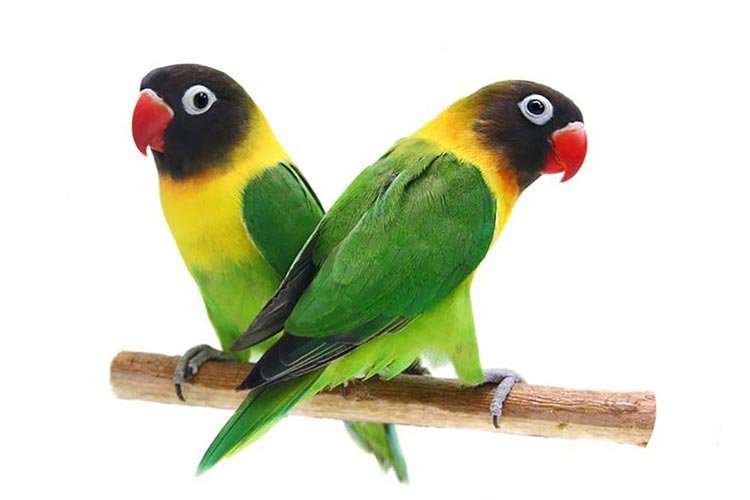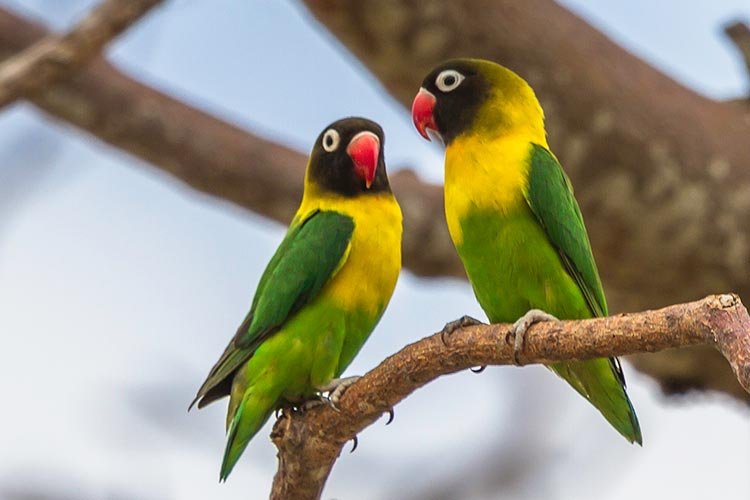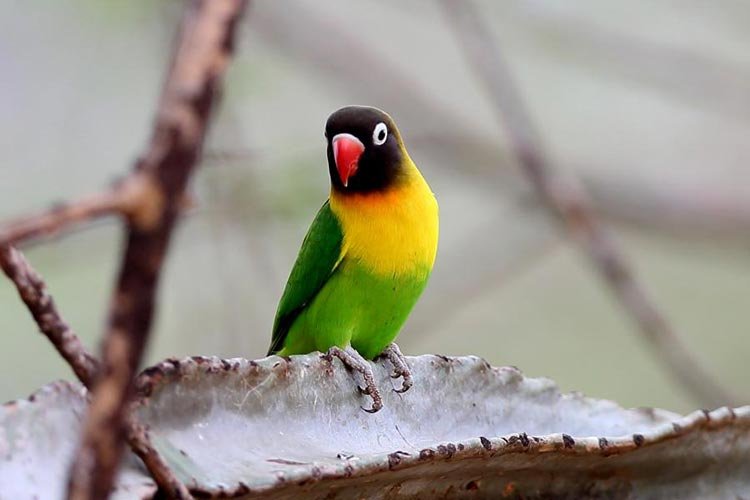
Black-masked lovebirds are beautiful, small parrots known for their intelligence, strong pair bond, and vibrant colors. They make excellent pet birds for both beginners and experienced bird owners. In this comprehensive guide, we’ll delve into the world of black-masked lovebirds, covering everything from their natural habitat to their care, breeding, and health.
Appearance and Characteristics
Physical Attributes
Black-masked lovebirds, sometimes referred to as yellow-collared lovebirds or yellow chest lovebird are small parrots, measuring approximately 6 inches in length. They are named after their blackish brown mask which covers their face and extends to their bright red beak. These charming birds also have a bright yellow collar around their neck, separating the black mask from their beautiful bright green body. Their wings and tails are mostly green, with blue or purple hues on the tips of their flight feathers.
Their vibrant colors and playful behavior make them popular pets, much like the closely related Lilian’s Lovebirds.
Behavior and Personality
These little black-masked lovebirds are known for their playful and social nature. They make ideal companion birds due to their affectionate personality and strong pair bond. Black-masked lovebirds can become very attached to their owners, often showing a preference for one person. They are also known for their squeaky speaking voice, which makes them charming and entertaining pets.
Yellow-Collared Lovebird: one of its common names
The yellow-collared lovebird is another name for the black-masked lovebird, and this alternate moniker is derived from the bird’s distinctive physical appearance. The name “yellow-collared lovebird” highlights one of the most eye-catching features of this small parrot – the bright yellow collar that encircles their neck. This collar serves as a separator between the bird’s blackish brown mask and their predominantly green body.
In addition to the black mask and bright green body, the yellow-collared lovebird also boasts a beautiful bright red beak and green wings with blue or purple hues on the tips of their flight feathers. The combination of these colors creates an attractive and vibrant visual display, which has contributed to the popularity of the yellow-collared lovebird as a pet. Whether referred to as the black-masked lovebird or the yellow-collared lovebird, these charming birds are captivating pets and engaging companions, bringing joy to bird enthusiasts worldwide.

Natural Habitat and Distribution
Black-masked lovebirds are native to the well wooded grasslands of east and south Tanzania, where they live in pairs or small flocks. They are often found in acacia trees and other scrubby trees. While their natural habitat is shrinking due to deforestation, feral populations exist in other parts of the world, such as Kenya, Burundi, and even parts of Europe.
Housing Black-masked Lovebirds
Cage Requirements
When housing black-masked lovebirds, which are among the most common pet birds worldwide, it’s essential to provide them with a spacious cage to accommodate their active lifestyle. A minimum cage size of 24 x 24 x 24 inches is recommended, but larger is always better. The cage should have horizontal bars for climbing and perching. The bird cage should also be equipped with a variety of perches, such as wooden dowels, natural branches, and small rope perches. Avoid using sandpaper perch covers as they can cause foot problems.
When it comes to breeding black-masked lovebirds, a separate breeding cage is highly recommended. Breeding cages are typically larger and provide the necessary space for nesting and raising chicks. They should also be equipped with a nesting box and additional perches to support the breeding process and create a comfortable environment for the lovebirds to mate, lay eggs, and raise their offspring.
Environmental Enrichment
Black-masked lovebirds are intelligent and curious, so it’s essential to keep their environment stimulating to prevent boredom. Provide a variety of toys, such as little plastic fake birds, puzzle toys, and foraging toys to keep your bird busy. Make sure to rotate toys regularly to maintain their interest.
Diet and Nutrition
Caring for a masked lovebird, whether it’s a young bird or mature birds, involves providing a well-balanced diet to ensure proper growth and overall health. It’s important to introduce a diverse range of food items when the bird is at a young age to help them develop a taste for various foods. A typical masked lovebird diet should include a mix of high-quality seeds, pellets, fresh fruits, vegetables, and occasional treats. Keep in mind that what a bird eats plays a crucial role in their overall health and well-being. Providing a nutritious diet can help prevent common issues that birds face, such as malnutrition or obesity.
Seed Mixes
A balanced diet is crucial for the health and well-being of your black-masked lovebird. While only seed mixes are often marketed as a complete diet, it’s essential to provide a variety of foods to ensure your bird gets all the necessary nutrients.
Fresh Foods
In addition to seeds, black-masked lovebirds should be offered a variety of other fresh foods. This includes vegetables, fruits, and grains. Offer small amounts of leafy greens, carrots, broccoli, and other veggies daily. Fruits such as apples, oranges, and bananas can be given as occasional treats.
Commercial Egg Food
During the breeding season or when raising chicks, black-masked lovebirds may benefit from the addition of commercial egg food to their diet. This provides extra protein and nutrients to support healthy growth and development.
Additionally, boiled eggs can also be a valuable source of nutrition for black-masked lovebirds during the breeding season or when raising chicks. By finely chopping hard-boiled eggs and mixing them with their regular diet, you can provide an extra boost of protein and essential nutrients that contribute to the healthy growth and development of the young birds. It is essential, however, to remove any uneaten boiled eggs from the cage within a few hours to prevent spoilage and maintain a clean environment for your feathered friends.
Health and Wellness
Common Health Issues
Black-masked lovebirds can suffer from various health issues, such as feather disease, liver disease, and respiratory infections. Maintaining a clean environment, providing a balanced diet, and ensuring proper veterinary care can help keep your bird in good health.
Proper Care
To maintain your black-masked lovebird’s overall health and maintain excellent plumage, it’s essential to provide regular baths or mist them with a fine mist spray bottle. This helps keep their feathers clean and in good condition. Regular vet check-ups and monitoring for signs of illness are also crucial in ensuring a long and healthy life for your pet bird.
Breeding and Reproduction
Breeding Season
Breeding black-masked lovebirds, a colorful lively pair, usually occurs during the wet season, which typically falls between January and June. However, in captivity, they may breed year-round if provided with the proper environment and care.
Nest Box and Nest Material
To encourage breeding, provide your black-masked lovebirds with a nest box and appropriate nesting materials such as shredded paper, hay, or coconut fibers. The small wooden box should be attached to the side of the breeding cage and have an entrance hole large enough for the birds to enter comfortably.
Hand Feeding
If you plan to hand-raise the chicks, you will need to start hand feeding them when they are about two weeks old. This process requires patience, care, and knowledge of the proper techniques to ensure the chicks’ health and well-being. Hand-fed chicks usually develop a strong bond with their caregivers and make exceptionally friendly and tame pets.

Color Variations and Mutations
Black-masked lovebirds display a variety of color mutations, which makes them even more appealing to bird enthusiasts. Some of the most popular color mutations include:
Blue-Masked Lovebirds
Blue-masked lovebirds are a stunning mutation that features a vivid blue body instead of the normal green color. The black mask and yellow collar remain the same, creating a striking contrast.
The blue masked lovebird is not only visually appealing but also shares similar behavior and care requirements with the standard black-masked lovebird.
In addition to the blue masked lovebird, there are several other mutations and color varieties of the black-masked lovebird species. Each one has its own unique charm and beauty. It’s essential to provide proper care and housing to ensure that these colorful birds maintain excellent plumage and good health throughout their lives, regardless of their specific color variation.
Green Masked Lovebirds
Green-masked lovebirds are a variation where the black mask is replaced with a green mask, giving them a more uniform appearance. This mutation is less common but equally beautiful, and like the black-masked lovebird, they make captivating pets and engaging companions.
Other Color Mutations
In addition to the blue and green mutations, there are many other color variations such as lutino, cinnamon, pied, and violet. These mutations can create a dazzling array of colors, making black-masked lovebirds even more captivating.
Conclusion
Black-masked lovebirds , listed as “Least Concern” on the IUCN Red List of conservation scale, are charming, intelligent, and affectionate pets that can bring joy and companionship to bird lovers of all experience levels. By providing a spacious cage, a balanced diet, regular baths, and proper veterinary care, you can ensure a long and healthy life for your delightful feathered friend. With their striking colors and engaging personalities, black-masked lovebirds are sure to steal your heart and become a cherished member of your family.
